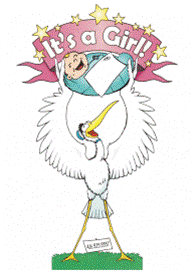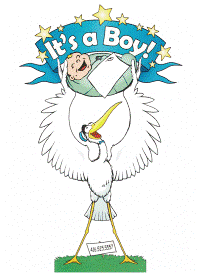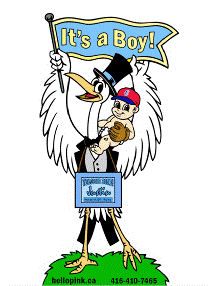
Written by John McKeown
A recent decision of the Federal Court relating to a claim of trademark infringement considered a defence based on alleged functionality of the trademarks in issue.
The Facts
The plaintiff’s business relates to renting what the parties call “lawn storks”, i.e. large signs depicting a stork and a newborn baby, intended to be placed on a customer’s front lawn to announce the birth of a child or a related event.
The plaintiffs applied for registration of two stork images it used as trademarks. The images were registered as trademarks in association with “lawn ornaments, namely lawn storks” and “7 day rental service of the stork image on a wooden plank, planted on the front lawn of the customer’s home, for the purpose of announcing the birth of their child or children.” The registrations include claims to specific colours as a part of the marks. Shown in colour, the Stork Market Images appear below:


The defendants are also in the business of rental and installation of lawn signs for special occasions.
The defendants initially used a traditional stork image depicting a stork carrying a baby in its beak, which was not similar to the plaintiffs’ stork images. In June 2010, the defendants rented lawn signs with new stork images, again employing both “girl” and “boy” versions. The defendants’ new Images (the “Images”) appear below:


After learning of defendant’s lawn signs using the above images a representative of the plaintiffs telephoned the defendant’s representative to ask them to stop using the Images but the defendants refused. The plaintiffs’ counsel sent a “cease-and-desist” letter but the Defendants did not respond to this correspondence, and an action was brought in the Federal Court.
The Action
Among other defences the defendants attacked the validity of the registrations owned by the plaintiffs. The Defendants’ position was that, if the stork image was removed, the wares would no longer function as “lawn storks” and the service would no longer function as “rental service of the Stork image …”. They argued that the subject of the registrations was primarily functional and/or merely ornamental and that registration as a trademark was precluded by the doctrine of functionality.
Functionality
The Trademarks Act deals expressly with the functionality of a distinguishing guise but it is well established that a similar concept applies to a regular trademark. If the functionality relates either to the trademark itself, for example, a transparent moisture proof wrapper for cigarettes or to the wares, for example where a design accentuated the darker colouring of the grain of the wood in tool handles, this is inconsistent with registration. However, if the functionality is secondary or peripheral with no essential connection to the wares, for example a telephone number for pizza delivery, this will not be a bar to registration.
Trademark protection is not available for a mark or get up that is “purely” functional. It does not exclude from protection any and every mark which displays functional features if they create no monopoly of the function.
The functionality concept ensures that an applicant does not indirectly achieve the status of a patent holder, with an unlimited term of protection, by obtaining a trademark registration. It would be abusive and unfair to the public to allow a person to gain the benefits of a patent by obtaining a trademark registration, especially when a person otherwise could not obtain a patent or when the patent in issue has expired.
The Judge stated that he had difficulty concluding that the plaintiffs’ registrations offended the doctrine of functionality. The registrations did not represent a shaping of goods or their containers or a mode of wrapping or packaging goods. In addition the plaintiffs’ claims could not be characterized as an effort to assert a protection that would be the subject of a patent. As a result the judge concluded that the marks were not primarily functional.
The judge also said that he was conscious that the images for which the plaintiffs claimed trademark protection are themselves an integral part of its product and service. However, the defendants had not established this disentitled the plaintiffs to protection. A product can have features which serve a utilitarian function and also serve the trademark function of identifying the source of the product, without invalidating the mark. While the images formed part of the plaintiffs’ product and service, they also served a source-distinguishing function.
The judge having found in favor of the plaintiffs on this issue then concluded that the defendants had infringed the plaintiffs’ registered trademarks.
Comment
While it can be difficult to apply the doctrine of functionality the refusal to apply it in this case seems reasonable. Although the plaintiff’s registrations show a lawn ornament made up of a stork there are many other ways to depict a stork which suggests that the plaintiff’s depiction was secondary or peripheral and not purely functional.
John S. McKeown
Goldman Sloan Nash & Haber LLP
480 University Avenue, Suite 1600
Toronto, Ontario M5G 1V2
Direct Line: (416) 597-3371
Fax: (416) 597-3370
Email: mckeown@gsnh.com
These comments are of a general nature and not intended to provide legal advice as individual situations will differ and should be discussed with a lawyer.
©2017 John S. McKeown
All rights reserved.
